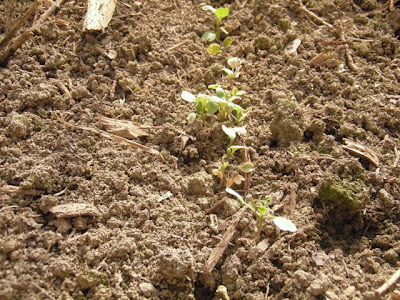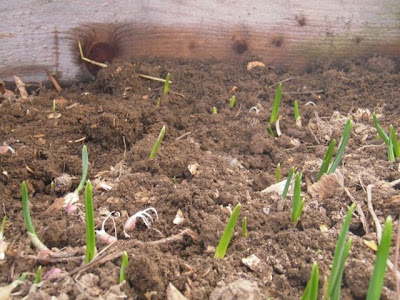It's good to make use of local resources. There's a local garden writer who discussed how he gets crab waste from a crab picking shop for his garden. It seemed like a good idea so I went around to a few crab shops and asked if they had picked out bodies to get rid of. They looked at me and said, "Do you know a guy named (insert garden writer's name here)?"
Let me back up. That crab meat you get in the grocery store doesn't just fall out of the shell. There's no machine to pull it out either. There are people who hand pick the meat from the crabs. They buy the live crabs from fishermen, usually lobstermen who catch them when the lobsters are elsewhere. They steam them to kill and cook them, then they bring the crabs into a clean room where a row of pickers slowly disassemble them. They pull off the legs one by one and scoop out the meat with various small picks and other tools. All the waste, which is a significant portion of the crab, goes into a bucket, to be emptied into a trash can provided by me.
I got the 'contract' when said writer called me up one day. I'd run into him in the Co-op, and asked him where he didn't get crab shell. A month or two later he called me up and said he had more than he could use, and made introductions for me at that shop. The deal is, I supply the barrels and take them away when they're full. I get the resource, and the crab shop gets it hauled away free.
I've tried to spread the wealth some. I've given some to neighbors, several of whom are homesteader/small farmer types. There was that time I gave some (only two barrels) to some folks who weren't so familiar with the concept. I dropped them off, and two days later got a call. "Dan, come take them back, PLEASE! They're, uh, surrounded by crawling things." So the next morning I picked them up when it was cool and dumped them in my back yard under my favorite apple tree. The crawlies were gone by noon.
Yes, they reek. Right now they're not so bad, because it's early February (feels like early March) and there are no flies active. But in May and beyond, the flies come and when I pull open the lid, it's a wriggling mass of maggots. And there's the "juice" that drips down to the bottom of the barrel that works as a good liquid fertilizer concentrate if you can bear it. Another friend of mine who's a former Paramedic, used to blood and gore and all that, had to step back a good long way.
That's the down side. The up side is that it's free fertility. It's said to be 23% calcium in the shells, and 60% protein. 60% protein means that 10% of the whole dry weight is nitrogen. I imagine there's a little phosphate in there too, but much less, proportionately. Now nitrogen and calcium are generally soluble, so this should keep things topped up on that side. Phosphate and potash aren't so soluble, and I've added enough wood chips, stable cleanings, etc, that I should have acceptable levels of those. I should probably get a soil test some time to check all these things.
Up until early last fall I had a 2000 Toyota Tacoma, but they took it away because of frame rust. I liked that truck, but nobody makes a 4 cylinder, 5 speed, 2wd, extra-cab truck any more. I ended up getting a beat up Subaru wagon and building this trailer to replace the truck. With the truck, I had a 26" tail gate height, and I could put three, then two, then two, then three 32 gallon plastic trash cans in the bed and slam the tail gate. Sometimes I'd put three more on the tail gate and tie them on. With the trailer, I have to think more about weight and balance. The springs, axle, and tires are rated at 1000#, and the trailer hitch is rated for 300# tongue weight. The axle is a little behind the center of the bed, so it balances at 6 cans forward of the axle and 4 cans aft. I hate to think of what these 8" wheels look like when they hit a pothole or frost heave, but they haul the load.

The lights are flat LED truck lights, protected within angle iron C-channels. I've had enough of the other sort of trailer lights that always get broken on something. The floor boards are spaced so that dirt and crud can sift through. The sides are 16" tall plywood, which is enough to hold the barrels fairly well. The bed is 96" long and 40" wide, so a 4x8 sheet will fit in on the diagonal, and the barrels fit in easily, two abreast, without much space to rattle around side to side. I've thought about a slightly wider axle and 12" tires, but why overwhelm the car by increasing the trailer capacity?
You can see the rope across the tail gate. The tail gate is just tied in place and comes off easily for loading. It actually makes for easier loading than when I had the truck, because the trailer deck is so low. It's very close to the height of the bed in a garden cart, so I get the cart close and walk the barrel from trailer to cart fairly easily. I can get three barrels in a cart, but sometimes two is a better idea. I dump them in rows, more or less, in the garden, and then my "crew" comes and rakes them out over the course of several days.
This particular patch is in the northwest quarter of the garden. It got a lot of wood chips last year, but still went to weeds after I hurt my back. Chickens digging will help keep weeds under control, and giving them some incentive to dig and scratch doesn't hurt.
The one other drawback of spreading the shells at this time of year is that anything not bound up in the shell can wash away quickly. I regret this, but there's 300' of field between where I dumped them and the pond. Hopefully the runoff will be filtered by the soil organisms and I won't be losing those nutrients. I do sometimes think of the Chinese compost houses in Farmers of Forty Centuries, and how I could compost the shells with waste hay, wood chips, and seaweed before spreading it on the garden. Maybe someday.
The other option is to till them in. One year I did an accidental experiment where I surface spread in one area and tilled the crabs in in another. Tilling in is clearly the better way to go. But right now the soil is frozen, the tiller is broken, and I haven't figured that into my management scheme.
While I was out there I noticed a few things about the 6' x 12' mini-tunnel. I noticed that the soil outside (frozen) was several inches taller than the soil inside. Once I moved the mini-tunnel, I put the garden cart astride where the north edge had been to make the difference clearer.
That's how much frost expands this soil.
I also noticed how things were going inside the mini-tunnel. Grass was sprouting and the soil wasn't frozen. The chickens like this. In this picture, you can just see the old bits of crab shell and wood chips remaining in the soil from previous applications.
This means that if I spread plastic over areas of the garden, it should be thawed pretty soon. It means I should go after that one thawed area with a spading fork to amuse the chickens and discourage the grass. And it means that I could be making better use of that mini-tunnel, even if it is an awkward size, not big enough to move around in comfortably and too big to lift easily.


















































